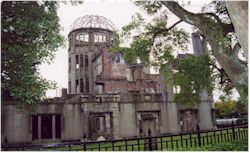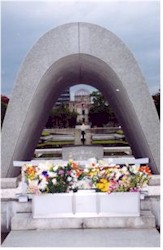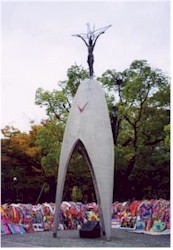| Hiroshima[links] |
October 28 - October 29, 2000 |
||
Like Nagasaki, the main sights of Hiroshima involve the A-Bombing. The distinctive features of the Hiroshima Peace Park are the Peace Flame, the Children's Memorial, and the Hiroshima Dome. The A-Bomb Dome is the skeletal remains of the Industrial Promotion Hall, with its distinctive dome top. The building's remains have been reinforced from the inside to ensure structural integrity. It's quite a sight. Moving on into the main part of the park, you pass the Children's Memorial. What victim of any horror is more innocent than a child? Atop the structure is a statue of a young girl, her arms outstretched, holding a paper crane. The statue was inspired by the true story of dying girl (radiation from the bomb), who believed that if she could fold a thousand paper cranes, she would live. She folded over a thousand, but still died of leukemia. Today, children bring paper cranes to set around the monument. The ground around it was strewn with them, some great strings of them, clearly done as classroom projects, others individual cranes. As you move on through the park, you pass the Peace Flame, which will burn until all Atomic weapons are destroyed. Here's hoping that day is not too far off. Further on toward the A-Bomb Museum is a fascinating structure, called the Memorial Cenotaph. The structure is made of stone, and shaped like a saddle. Under the arch is a stone chest containing the names of the victims of the bombing. Inscribed on the arch is the statement (in Japanese): "Repose ye in Peace, for the error shall not be repeated." The Atomic Bomb Museum was amazing. Since we could not take pictures, I'll let Elaine's words describe it:
Depressing though it was, it is a truly worthwhile experience. I walked in there somewhat ignorant about the true horror of the bombing, and came out realizing that our current weapons are much, much more powerful than the A-Bomb was. We're talking thousands of times more powerful. It's pretty scary. I highly recommend the Peace Park and Museum, but there was another place to see, not far from Hiroshima. Since we had been told by two different people back home that we HAD to go, we did. A hop, skip, and a jump...to Miyajima... Hiroshima Links: [ Main Page ]
|
|||

The A-Bomb Dome, the remains of a building damaged in the blast. |
|||
|
The monument to the children of Hiroshima killed in the blast. The colorful stuff on the ground is thousands of paper cranes placed by children. |
|||
|
The Peace Flame, which will burn until all nuclear arms are destroyed. |
|||

This monument is called the Memorial Cenotaph. Under the saddle-shaped structure is a stone chest containing the names of the victims of the Hiroshima bombing. |
|||
|
|

